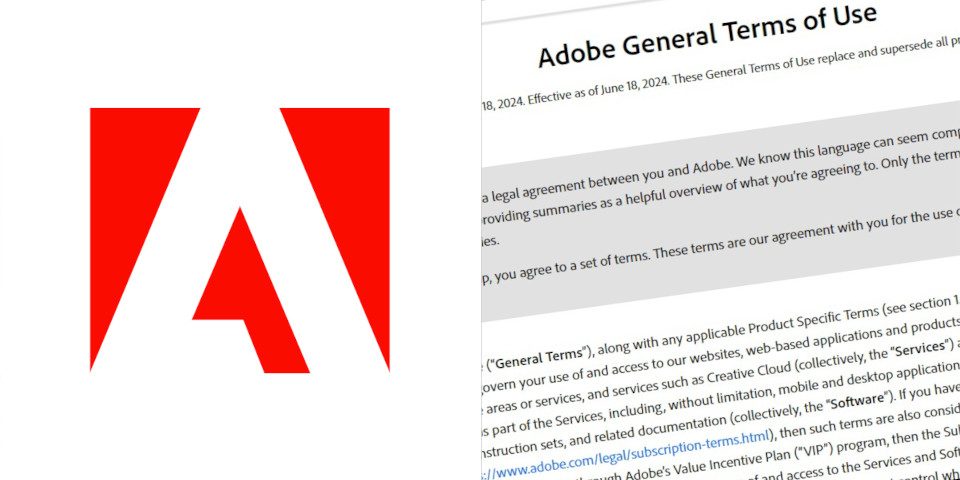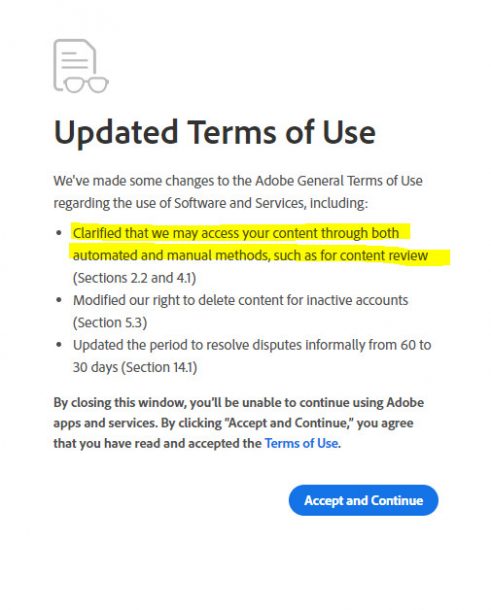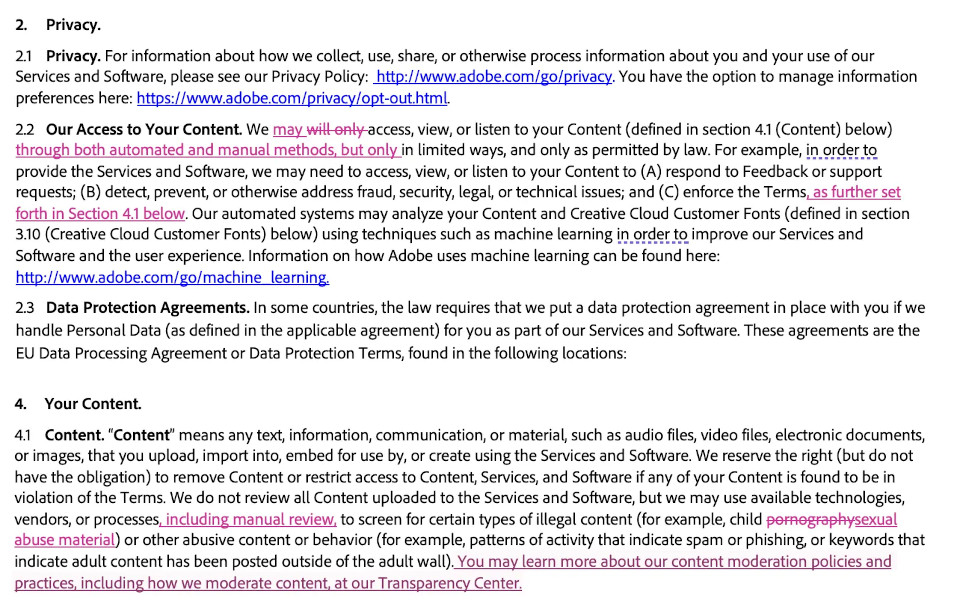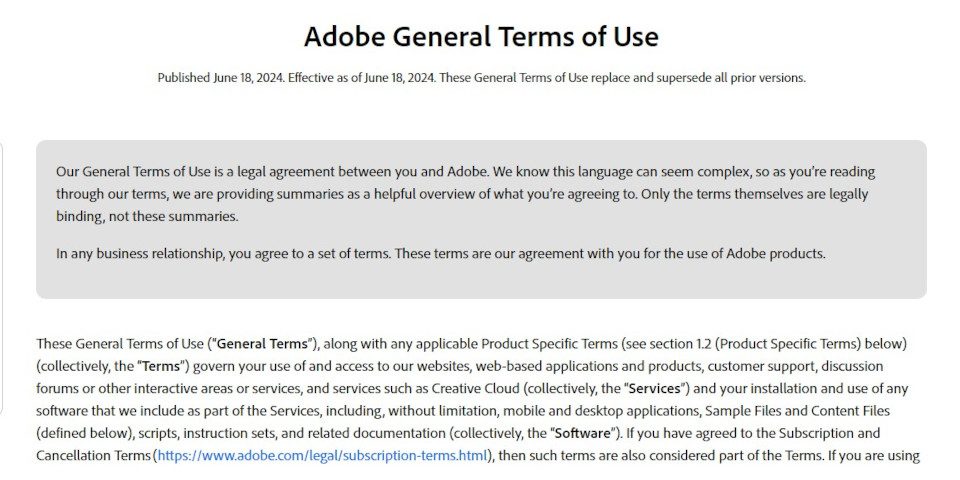Adobe updates its Terms of Use following artist backlash

Adobe has been forced to update its Terms of Use following a very public backlash from artists about how the company accesses users’ content, including fears about whether it is used to train generative AI models.
The terms, which apply to Creative Cloud applications like Photoshop and After Effects and services like Behance, now include plain-English summaries of key sections.
They include categorical assurances that Adobe does not “scan or review content that is stored locally on your device”, and that it does not train generative AI models on users’ content unless they are selling it through the Adobe Stock marketplace.
So what else do the updated terms say – and why were they updated in the first place? Below, we’ve put together our FAQs about the Adobe Terms of Use controversy.

What was it about Adobe’s Terms of Use that prompted a backlash from users?
The row erupted earlier this month after some Adobe users received a pop-up notifying them of changes to the company’s General Terms of Use.
Four sections of the terms – which apply to software like Photoshop and After Effects and Creative Cloud services like Behance – were updated, but the one that caused the fuss was the one highlighted in the screenshot above, taken from this user tweet.
That line – that Adobe “may access your content through both automated and manual methods” – prompted a lot of negative feedback online, like this Reddit thread.
“So Adobe can now spy on all the projects being worked on right now? That’s insane,” reads one fairly representative comment.
What had Adobe actually changed in its Terms of Use?
The changes to the General Terms of Use had actually been made on 17 February 2024, but went unnoticed by most users until Adobe pushed what it describes as a “routine re-acceptance” of the changes to Creative Cloud and Document Cloud users.
For many of those users, the resulting pop-up was the first time their attention had been drawn to the fact that Adobe can access the content that they create, and it provided no information about how or why the company was actually doing so.
The fact that re-acceptance was mandatory – you had to accept the pop-up in order to carry on using the Adobe application in question – only fuelled suspicion.

Adobe’s original changes to its Terms of Use, shown in its blog post from 6 June.
What did Adobe do in response to the controversy?
In response to the backlash, Adobe first issued a “clarification” of the terms of use, including a before-and-after comparison of the actual changes to the wording.
In its blog post, the company said that its intention had been to “be clearer about [the] moderation processes that we have in place”, including the fact that it had “added more human moderation to our content submissions review processes”.
Four days later, as the negative feedback continued, it posted a second statement saying that it now intended to update the terms of use again.
In it, Adobe said that it “should have modernized [the] terms of use sooner”, and that it intended to “explain our legal requirements in easy-to-understand language”.

Adobe’s new Terms of Use, rolled out on 18 June, include more detail on how the company accesses users’ data, and includes plain-English summaries of key sections.
What are Adobe’s current Terms of Use?
That process has resulted in the new Terms of Use, which were published on 18 June.
The ‘Our Access to Your Content’ section has been expanded to provide more detail on how and why Adobe accesses the content that its users create.
In addition, gray boxes at the start of many sections provide plain-English summaries of what those sections actually mean – although there is a disclaimer that “only the terms themselves are legally binding, not these summaries”.
Can Adobe access content on my local machine?
Yes, but probably not to do anything underhanded.
The Terms of Use state that Adobe can access local content – that is, content on users’ laptops or workstations – for the “normal running” of software or services.
The example it gives is allowing Photoshop to open a file for editing.
However, they also state that Adobe does not “scan or review [local content]”, including a categorical statement that: “Your local content is never reviewed by us.”
Does Adobe ‘spy’ on its users’ content?
It depends on your definition of spying. The firm does scan cloud content – content created with cloud-based Adobe services, or uploaded to its servers – but it says that it does so mainly to weed out content that most people would think of as unacceptable.
Cloud content includes files created with tools like Photoshop on the web, stored in cloud documents and Creative Cloud libraries, or uploaded to Behance.
These files may be scanned “to ensure we are not hosting illegal or abusive content”.
You can read Adobe’s definition of harmful material on a separate webpage.
It ranges from the straightfowardly illegal, like images of child sexual abuse, to content promoting self-harm, terrorism or hate speech. Adobe also monitors cloud content for “patterns of activity that indicate spam or phishing”.
Human review occurs in “limited circumstances”: primarily when content is flagged by the automated process, or is reported as illegal by other users.
Does Adobe collect data from its users’ content?
Yes. By default, Adobe also does automated analysis on cloud content, using the data both to guide future updates to products, and to “provide recommendations” to users.
Users can opt out – there are instructions for doing so in Adobe’s content analysis FAQs – but only for standard services.
Users can’t opt out of having their data used for content analysis when using beta or pre-release software, or the voluntary Adobe Photoshop Improvement Program.
Does Adobe use its users’ content to train generative AI models?
Yes, but only if you sell it through the Adobe Stock marketplace.
Adobe’s current Terms of Service include a categorical statement that “we will not use your local or cloud content to train generative AI models except for content you choose to submit to the Adobe Stock marketplace”.
Images from Adobe Stock were used to train Firefly, Adobe’s set of generative AI tools, available online and inside software like Photoshop.
Adobe Stock contributors can’t opt out of having their images used for AI training, and VentureBeat reports that Adobe did not seek Stock contributors’ explicit consent first.
However, contributors do receive a fee for having their images used to train AI models, via the Firefly bonus compensation plan.
Will the changes to the Terms of Use end artists’ concerns about Adobe?
Probably not. At the time of writing there are over 500 replies to Adobe’s tweet announcing the latest update to the Terms of Use, and the majority are negative.
Many are along the lines of ‘too little, too late’, but some are from users who simply don’t believe Adobe.
In part, that reflects the deep suspicion that some artists have about generative AI; in part, it reflects the deep dislike that some artists have for Adobe’s business practices, particularly its role in shifting the CG industry towards subscription-only licensing.
It hasn’t helped Adobe that, two days before the updated Terms of Use were rolled out, the US Department of Justice filed a lawsuit against the company over its subscriptions policy – one that centers on whether it is sufficiently transparent with its users.
What’s the tl;dr from all of this?
Like a lot of large tech firms, Adobe had long, vaguely worded Terms of Use, and that vagueness makes users suspicious about what those firms are doing with their data – or what they may do with it in future.
The latest changes go some way towards clarifying the terms, and state explicitly – including in the legally binding sections – that Adobe does not scan content on users’ local machines, or train generative AI models on user content outside Adobe Stock.
However, given some artists’ feelings about generative AI and about Adobe itself, the changes seem unlikely to allay all of its users’ fears.
Read Adobe’s updated General Terms of Use for its software and services
Read Adobe’s FAQs on content analysis in Creative Cloud and Document Cloud apps
Read the Adobe Stock Contributor agreement
Visit Adobe’s online ‘Transparency Center’
(Includes information on Adobe’s content moderation policies)
Have your say on this story by following CG Channel on Facebook, Instagram and X (formerly Twitter). As well as being able to comment on stories, followers of our social media accounts can see videos we don’t post on the site itself, including making-ofs for the latest VFX movies, animations, games cinematics and motion graphics projects.
